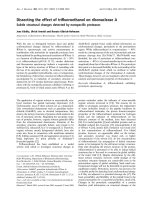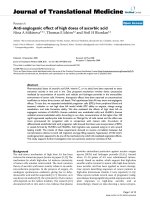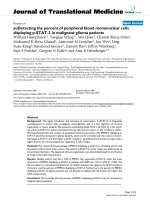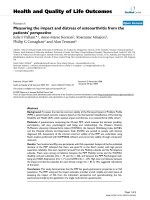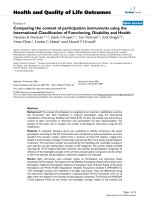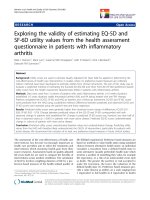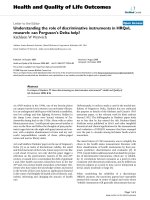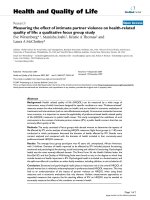Báo cáo hóa học: " Measuring the effect of intimate partner violence on health-related quality of life: a qualitative focus group study" pot
Bạn đang xem bản rút gọn của tài liệu. Xem và tải ngay bản đầy đủ của tài liệu tại đây (239.49 KB, 7 trang )
BioMed Central
Page 1 of 7
(page number not for citation purposes)
Health and Quality of Life
Open Access
Research
Measuring the effect of intimate partner violence on health-related
quality of life: a qualitative focus group study
Eve Wittenberg*
1
, Manisha Joshi
2
, Kristie A Thomas
2
and
Laura A McCloskey
3
Address:
1
Heller School for Social Policy and Management, Brandeis University, Waltham, MA, USA,
2
School of Social Policy and Practice,
University of Pennsylvania, Philadelphia, PA, USA and
3
Merrill-Palmer Skillman Institute, Wayne State University, Detroit, MI, USA
Email: Eve Wittenberg* - ; Manisha Joshi - ; Kristie A Thomas - ;
Laura A McCloskey -
* Corresponding author
Abstract
Background: Health related quality of life (HRQOL) can be measured by a wide range of
instruments, many of which have been designed for specific conditions or uses. "Preference-based"
measures assess the value individuals place on health, and are included in economic evaluations of
treatments and interventions (such as cost effectiveness analysis). As economic evaluation becomes
more common, it is important to assess the applicability of preference-based health related quality
of life (HRQOL) measures to public health issues. This study investigated the usefulness of such
instruments in the context of intimate partner violence (IPV), a public health concern that that can
seriously affect quality of life.
Methods: The study consisted of focus groups with abused women to determine the aspects of
life affected by IPV, and an analysis of existing HRQOL measures. Eight focus groups (n = 40) were
conducted in which participants discussed the domains of health affected by IPV. Results were
content analyzed and compared with the domains of health included in four commonly-used,
preference-based HRQOL measures.
Results: The average focus group participant was 43 years old, unemployed, African American,
with 3 children. Domains of health reported to be affected by IPV included physical functioning,
emotional and psychological functioning, social functioning and children's functioning. Psychological
health was the most severely affected domain. The Short Form 36, the Health Utilities Index, the
EuroQol 5D, and the Quality of Well-being Scale were found to vary in the degree to which they
include domains of health important in IPV. Psychological health is included to a limited extent, and
the spill-over effect of a condition on other family members, including children, is not included at all.
Conclusion: Emotional and psychological health plays an important role in the overall HRQOL of
abused women but is relatively underemphasized in preference-based HRQOL measures. This may
lead to an underestimation of the impact of partner violence on HRQOL when using these
measures and in economic evaluations that rely thereon. Holistic measurement approaches or
expanded measures that capture the far-reaching effects of IPV on HRQOL may be needed to
accurately measure the effect of this condition on women's health.
Published: 19 December 2007
Health and Quality of Life Outcomes 2007, 5:67 doi:10.1186/1477-7525-5-67
Received: 14 September 2007
Accepted: 19 December 2007
This article is available from: />© 2007 Wittenberg et al; licensee BioMed Central Ltd.
This is an Open Access article distributed under the terms of the Creative Commons Attribution License ( />),
which permits unrestricted use, distribution, and reproduction in any medium, provided the original work is properly cited.
Health and Quality of Life Outcomes 2007, 5:67 />Page 2 of 7
(page number not for citation purposes)
Background
Intimate partner violence (IPV) has wide-ranging and
oftentimes unmeasured effects on health and quality of
life[1]. IPV is relatively common compared with other
conditions that affect the health of women: one in four
women in the United States reports experiencing violence
from an intimate partner over her lifetime, and each year
at least 1.5 million women are assaulted by intimate part-
ners[2]. The documented health effects of partner abuse
range from severe injury or even death to somatic com-
plaints[3]. Compared with women who have not been
abused, abused women report more health symptoms
such as headaches and gynecologic discomfort[4,5], and
they are more likely to be diagnosed with specific condi-
tions such as irritable bowel syndrome, arthritis, and a
range of serious conditions entailing hospitalization [4-
6], and are more likely to be depressed[7].
The effect of IPV on quality of life has been less studied.
Measures of quality of life are useful for understanding the
subjective effect of health on individuals, including the
perception of well-being that accompanies specific symp-
toms or diagnoses. Quality of life is also useful in out-
come evaluations, providing a quantitative measure of the
effect of a condition on individuals' lives and thereby a
measure of the benefit of preventing or intervening in that
condition. In particular, health related quality of life
(HRQOL) is often used in economic evaluations as a com-
ponent of the benefit derived from an intervention, which
demonstrates effectiveness as well as cost-effectiveness
when compared with costs.
Health-related quality of life is a general term that
describes the overall impact of a disease, illness or condi-
tion on the health and well-being of the affected individ-
ual. HRQOL can describe an individual's health and well-
being in terms of symptoms and functioning, or it can
reflect how an individual values a particular state of health,
meaning how much they like or dislike being in that par-
ticular state of health and well-being. This value-focused
measure of HRQOL is termed "preference-based" because
it measures an individual's preference for a health state, as
opposed to an individual's description of the state[8]. Pref-
erence-based measures of HRQOL can be used in aggre-
gate to reflect the value that society as a whole associates
with being in a particular state of health[9]. Such values
are often used in decision making about prioritization of
resources across competing programs and interventions,
to answer questions such as should we spend resources to
prevent IPV versus automobile accidents, to treat HIV ver-
sus cancer? While the association between intimate part-
ner violence and specific health complaints has been
identified, we know little about the effect of IPV on overall
health related quality of life and the value that individuals
and society place on the effects of IPV on women's
lives[1].
There exist a wide variety of methods to measure prefer-
ence-based HRQOL. Approaches vary from directly ques-
tioning individuals with experience with a particular
condition about how they value it, to two-part methods in
which (1) an individual who has experienced a particular
condition describes it, and then (2) a separate set of values
is applied to these descriptions[8,9]. This two-part
method makes use of standardized instruments to collect
the descriptive information about a health condition from
people who have experience with it, prior to assigning val-
ues to these descriptions. Commonly-used instruments
include the Short-Form 36 (SF-36) and its variations (e.g.,
SF-12, SF-6D [10-12]), the Health Utilities Index (HUI
[13], the EuroQol 5D (EQ-5D [14]), and the Quality of
Well-Being Scale (QWB [15]). These instruments elicit
descriptive information about the effect of a disease or
condition on various domains of health, ranging from
things like vision and dexterity to social functioning and
vitality. These domains are intended to capture the range
of aspects of health that can be affected by disease, and
that are important to quality of life. (Note: While the HUI,
EQ-5D and QWB were designed as preference-based
measures, meaning they were designed to capture the
value that people place on being in a particular state of
health or having a particular condition, the SF-36 was
originally designed to measure health status, and methods
have subsequently been developed to translate it into a
preference-based measure [16-19])
While focusing individuals' attention on specific domains
of health may be helpful to elicit the full range of impact
of a condition, it may also exclude effects in domains not
specifically queried. We hypothesized that such a situa-
tion may exist in the case of intimate partner violence: that
certain domains of health affected by IPV may not be
included in these commonly-used HRQOL measures, and
thus the effect of IPV on HRQOL may be misestimated
when using such instruments. The purpose of this
research was therefore to expand our understanding of the
domains of health affected by IPV to accomplish two
goals: (1) to inform the health ramifications of partner
violence, and (2) to inform the measurement of the effect
of IPV on preference-based health related quality of life.
The ultimate goal of this research was to improve the
measurement of HRQOL by identifying potential sources
of measurement bias that may result from the inclusion
and exclusion of domains in instruments. We report here
on the results of focus groups of abused women discuss-
ing the health and quality of life effects of IPV, and a
review of preference-based health related quality of life
instruments designed to measure these effects.
Health and Quality of Life Outcomes 2007, 5:67 />Page 3 of 7
(page number not for citation purposes)
Methods
In this qualitative study we conducted focus groups with
abused women to measure perceptions of the effect of
intimate partner violence on health and quality of life. We
compared results from these groups with existing prefer-
ence-based HRQOL instruments to assess the adequacy of
these instruments to capture the aspects of health and
quality of life affected by IPV. The study was approved by
the University of Pennsylvania Institutional Review
Board.
Sample
Women were recruited via flyers posted in domestic vio-
lence shelters and service providers and their surrounding
areas in greater Philadelphia, PA. Potential participants
were screened by phone prior to participation in the
groups. Inclusion criteria included 18 years of age or
older, English-speaking, having been in a relationship
with a man and having experienced "physical abuse or
severe control from a male partner" in the past 12 months.
Fifty-nine women were recruited to the study of which 40
actually participated (some did not appear at their sched-
uled group and some exceeded the intended sample size).
Although not part of the recruitment plan, snowball sam-
pling occurred among women who attended a group and
their friends and relatives. All women in the study pro-
vided written, informed consent for participation.
Focus group procedures
Eight focus groups were conducted in Philadelphia in
March and April, 2006. Each group lasted between 60 and
90 minutes, was led by a trained moderator using a semi-
structured discussion protocol, and was audio taped. Par-
ticipants' transportation costs were reimbursed and they
were each remunerated $50 for their time. Childcare was
provided on site and a licensed social worker was availa-
ble to women during and after the groups.
Data collected
Demographic and abuse data were collected individually
from each woman including age, race, employment and
marital status, and number of children, and the Women's
Experience with Battering Scale (WEB[20]) and a modi-
fied version of the Conflict Tactics Scale (CTS [21]). The
WEB measures psychological terror or battering in a cur-
rent relationship and ranges in score from 10 to 60 where
20 or higher is indicative of battering. The CTS measures
frequency and severity of physical, emotional and sexual
abuse in both current and former relationships and a pos-
itive score indicates current abuse. While focus group dis-
cussions were wide-ranging and followed topics
mentioned during the conversations, moderators focused
the discussions on women's experience of IPV and the
impact on their physical and emotional health and well-
being. Descriptions of health related quality of life instru-
ments were obtained from the literature and published
sources.
Analysis
Demographic and abuse data were summarized with
descriptive statistics. The focus group audiotapes were
transcribed verbatim by three research assistants, none of
whom had contact with the participants. Transcription
reliability was checked in a random sample of sections by
the authors (KT and MJ) revealing discrepancy rates of
9.7% and 2%. Most discrepancies related to wording dif-
ferences or word omissions and very few changed the
actual meaning of the women's conversations. Transcripts
were coded by one author (EW) and a research assistant
for the domains of health and quality of life mentioned.
Each mentioned area in which health or quality of life was
affected was recorded, and affected areas were categorized
into domains of life and health. We mapped the affected
areas onto the domains used in four existing health
related quality of life instruments and added other
domains for those areas that were unrepresented in exist-
ing measures.
Results
Sample characteristics
The average participant was 43 years old, African Ameri-
can, single, unemployed and had three children (Table 1).
The majority of women reported current abuse by either
the Conflict Tactics Scale (mean score = 111) or the WEB
(mean score = 32). Four women had a CTS score of zero
and four had scores over 300 (three of the four with zero
CTS scores had scores that indicated battering on the
WEB, and the fourth had a score very close to the battering
threshold). Seventy-five percent of the women met the
WEB criterion for psychological battering. Over 40% of
the women reported IPV in prior years.
Focus group discussions
Women reported very severe physical, emotional and psy-
chological abuse, ranging from beatings, chokings, and
burns, to stalking, poisoning, imprisonment, rape, and
abuse of their children, pets and property (for more detail
on reports, see [22]). They reported that these experiences
affected their physical and emotional health in four gen-
eral categories: physical functioning, emotional and psy-
chological functioning, social functioning, and their
children's functioning (Table 2). Almost all of the women
reported that the emotional and psychological dimen-
sions of health were most significantly affected by abuse,
and they mentioned more emotional and psychological
than physical sequelae of abuse. The abuse manifested in
physical terms beyond the injuries inflicted upon them, in
symptoms such as headaches, insomnia, fatigue and high
blood pressure (Table 3). While some of these conditions
may have an etiology independent of the abuse, the
Health and Quality of Life Outcomes 2007, 5:67 />Page 4 of 7
(page number not for citation purposes)
women reported a self-perceived association between the
violence and their physical symptoms.
The women's reported emotional and psychological
symptoms include many of those of post-traumatic stress
disorder, such as hyper vigilance, flashbacks and night-
mares, fear, anger and aggression (Table 3). In every
group, women discussed experiences of shame and
embarrassment resulting from their abuse, and feelings of
loneliness, isolation, helplessness and depression were
common. They emphasized the importance of their loss
of freedom and control over their lives, exemplified by
experiences of interference at work (e.g., the abuser dis-
paraging the woman to her employer or injuries prevent-
ing her from working) and being physically prevented
from contacting friends or relatives. Most women
reported that the effect on their quality of life of the emo-
tional and psychological symptoms that resulted from IPV
was more important than that from the physical symp-
toms.
In addition to the direct effect of abuse on the women's
health and quality of life, women reported that their own
quality of life suffered from their knowledge of the nega-
tive effect that witnessing abuse had on their children.
Women reported significant changes in their children's
behavior which in turn resulted in an exacerbation of the
women's physical and emotional symptoms, including
increased worry, guilt, anxiety and depression. While
women reported that some children also experienced
direct abuse from the intimate partner, many reported on
the effect of witnessing their mother's abuse.
HRQOL instruments
The SF-36, HUI, EQ-5D and QWB instruments are limited
in their inclusion of emotional or psychological aspects of
health (Table 4). The longer instruments and those that
measure more domains of health tend to include more
psychological and emotional attributes of health, such as
the SF-36, which with eight domains measures "social
functioning," "role-emotional," and mental health. The
Health Utilities Index (Mark 3) includes "emotion" as one
of eight domains and the EuroQol includes "anxiety/
depression" as one of five domains. The Quality of Well
Being Scale does not directly measure emotional or psy-
chological health but includes "social activity" which may
encompass some aspects of emotional and psychological
health. Both the SF-36 and the EuroQol include holistic
assessments of health that might further elicit emotional
and psychological components of health, the SF-36
through "vitality" and "general health" domains and the
EuroQol through a visual analog scale (a 0–100 scale that
elicits a numerical representation of self-perceived overall
health). The visual analog scale in particular allows for an
encapsulation of all affected domains, but it does not
identify or differentiate among domains, thereby adding
sensitivity to the overall assessment but lacking specificity.
Table 1: Characteristics of sample: 40 women in 8 focus groups
Age: mean years (sd) 42.6 (10.6)
Range 18–64
Race/Ethnicity n (%)
African American 30 (79%)
White 3 (8%)
Latina 2 (5%)
Multiracial/ethnic 3 (8%)
Employment n (%)
Full-time 5 (13%)
Part-time 6 (15%)
Unemployed 28 (72%)
Marital Status n (%)
Married 16 (41%)
Divorced 4 (10%)
Single 19 (49%)
Has at least 1 child n (%) 31 (78%)
Number children: mean (sd) 3.3 (1.7)
CTS Score: mean (sd) 111 (122)
Range 0–380
WEB score: mean (sd) 32 (15)
range (%> = 20) 0–50 (75%)
IPV prior to last year n (%) 17 (43%)
%s may not sum to 100 due to rounding.
Employment and marital status missing for 1 woman each; Race
missing for 2.
CTS = Conflict Tactics Scale
WEB = Women's Experience with Battering Scale
IPV = Intimate partner violence
Table 2: Reported domains of life affected by intimate partner violence
Physical Functioning
E.g., headaches, insomnia, vomiting, fatigue/lethargy, heart palpitations, high blood pressure, addiction relapse
Emotional and psychological functioning
E.g., crying, sadness, anger, aggression, loneliness, worry and anxiety, depression, fear, helplessness and powerlessness, resignation, confusion,
shame, embarrassment, stress, paranoia, flashbacks and nightmares.
Social functioning
E.g., isolation from friends, family, religious groups; ostracization by family, friends and church; lack of confidence in police and service providers;
inability to work (due to interference by abuser or from poor health).
Children's functioning
E.g., aggression, anger, fighting; self-destructive behavior; nail biting; stuttering; gambling; substance abuse; poor school performance.
Health and Quality of Life Outcomes 2007, 5:67 />Page 5 of 7
(page number not for citation purposes)
Discussion
For women included in this study, the effects of violence
perpetrated by an intimate partner were concentrated in
the emotional and psychological domains of health
despite the apparent physical effects of abuse. Fear, con-
trol and power played significant roles in women's nega-
tive outcomes from IPV. Furthermore, children's
experience of witnessing IPV had a significant impact on
their mothers' HRQOL, beyond the effect on the children
themselves. Existing preference-based measures of
HRQOL focus more on the physical domains of health
than the emotional and psychological domains, contrary
to those which were most severely affected among the
women in our study. The importance of children's quality
of life to these mothers' HRQOL suggests the need for a
wider conception or definition of HRQOL, possibly focus-
ing on the family unit as a whole[23,24]. Measures of
HRQOL developed for physical illnesses may underesti-
mate the effect of IPV for some women, and resource deci-
sions made on this basis may possibly be misguided. To
adequately capture the HRQOL impact of IPV for these
women, HRQOL measures may need to include greater
and broader focus on psychological outcomes, or possibly
focus on holistic measures that include all aspects of self-
perceived quality of life.
Table 4: Domains included in Health-related Quality of Life
instruments
Short Form 36 [11, 12]
Physical functioning
Role–Physical
Bodily Pain
General Health
Vitality
Social functioning
Role–Emotional
Mental health
Health Utilities Index (Mark 3) [13]
Vision
Hearing
Speech
Ambulation
Dexterity
Emotion
Cognition
Pain
EuroQol 5D [14]
Mobility
Self-care
Usual activities
Pain/discomfort
Anxiety/depression
Visual analog scale
Quality of Well Being Scale [15]
Mobility
Physical activity
Social activity
Symptoms list
Table 3: Reported Physical and Emotional/Psychological
Symptoms of Abuse
Physical symptoms
Addiction relapse
Asthma
Fatigue
Graying hair
Headaches (migraines)
Heart attack
Heart palpitations
High blood pressure
Insomnia
Lethargy
Voice change
Emotional/psychological symptoms
Anger
Anxiety, nervousness
Apathy
Becoming abusive herself
Confusion
Crying
Depression
Difficulty focusing
Fear, including:
Fear of particular places (e.g., where abuse occurred)
Fear of losing children, fear of abandoning children
Fear of repercussions
Fear for life
Fear that medications will be tampered with
Fear of becoming abusive herself
Fear of impact of stress on other co-morbid conditions
Feelings of failure
Feelings of worthlessness
Feeling "on edge"
Feeling rejected/abandoned
Feeling trapped, stuck
Flashbacks
Frustration
Guilt
Helplessness/powerlessness
Hyper-awareness
Loneliness
Loss of self-esteem/loss of confidence
Loss of trust in others
Mood swings
Nightmares
Over-eating
Panic
Paranoia
Resignation
Sadness
Self-blame
Self-consciousness
Self-hatred
Shame, embarrassment
Stress
Suicide attempts
Suicidal ideation
Worry
Health and Quality of Life Outcomes 2007, 5:67 />Page 6 of 7
(page number not for citation purposes)
Generic HRQOL instruments are extremely valuable
because of their ease of use and adaptation to many vary-
ing conditions. Preference-based measures of HRQOL are
particularly important because of their role in economic
evaluations upon which resource allocation decisions are
often based. The benefit attributed to particular interven-
tions is oftentimes measured with preference-based meas-
ures of HRQOL, meaning that accurate assessment of
benefits is dependent upon accurate measurement instru-
ments. In this context, the decision to allocate resources to
IPV prevention or intervention efforts may hinge upon
accurate measurement of the impact of IPV on quality of
life and hence the benefit that would accrue from prevent-
ing or intervening in violence. While many of the existing
preference-based HRQOL instruments were originally
designed to measure the effect of medical conditions (e.g.,
[25]), they have been adopted for more general use
because of their ease of use and comparability across con-
ditions. The prevalent use of these measures requires that
they be considered for a broader range of uses than may
have been originally intended, including non-medical
conditions such as IPV, and that they be adapted accord-
ingly.
Researchers measuring HRQOL for any purpose should
take care to choose measures that encapsulate the entirely
of impact of a condition on health, and define health in
an appropriate way for the condition under considera-
tion[26]. The domains specified by each instrument
define the aspects of life that are included and excluded in
that assessment of HRQOL. When choosing among
instruments, researchers should consider the aspects of
health and life that are expected be affected by a condi-
tion. Notice should also be taken of the more general or
holistic elements included in some instruments, such as
the visual analog scale in the EuroQol and the general
health measure in the SF-36, which may capture aspects of
health not otherwise included in specified domains. These
general measures may also be considered as a validity
check of other domains included in a composite measure,
or to inform the more subjective aspects of HRQOL. Our
results suggest that for at least some women, measuring
the effect of IPV on HRQOL may require a broader defini-
tion of health than is included in commonly-used, prefer-
ence-based measures of HRQOL in order to adequately
capture the entirely of their experience. Other health con-
ditions may have similar impacts on aspects of life and
health that are not included in generic HRQOL measures,
and should be explored to obtain unbiased estimates of
the burden of the condition/disease on those affected.
Of particular note are the effects of health conditions on
individuals surrounding the index person or patient,
including family members and caretakers[23,27]. Such
effects are often difficult to measure, yet may make a sig-
nificant contribution to the overall impact of a disease or
condition. The "spillover" effect of children's health on
their parents' quality of life is occasionally consid-
ered[28], as well as the effect of illness on siblings[23,29].
Measurement of the indirect connection between parent
and child HRQOL that we observed in our sample, in
which the health of the woman affects the child which in
turn further affects the woman, is unprecedented in
HRQOL measures. Our observation of the significant
impact of children's distress on their mother's HRQOL
suggests the need for the inclusion of a new domain in the
measurement of HRQOL in this context, and potentially
in others as well.
It is important to acknowledge that the data on which this
research is based has extraordinary richness but accord-
ingly limited generalizability. We spoke with 40 women,
mostly African American, from one urban area. It is not
known whether the emotional and psychological impact
of violence differs by race or geographic location, so our
results must be considered in context and with caution.
And though our data are self-reported and unconfirmed
by objective measures, we believe that self-report bias
would tend toward underreporting of abuse and the
impact thereof, so our results might be considered a lower
bound of the effect. The qualitative reports of HRQOL by
women in our focus groups are consistent with their CTS
and WEB scores, providing some internal consistency in
our data. Nevertheless, further research on abused women
and the range of effects of violence on their lives would be
a welcome addition to the sparse literature on outcomes
of IPV.
Conclusion
In conclusion, IPV has substantial effects on women's
health related quality of life in areas that may not have
been previously identified. Misunderstanding or underes-
timation of the impact of IPV on HRQOL could lead to
inefficient allocation of resources from a health and social
policy perspective of endeavoring to provide the greatest
benefit from resources spent on prevention and interven-
tion. Efforts to accurately identify and measure the
impacts of IPV on women's health and quality of life may
lead to more effective interventions and policy decisions.
Abbreviations
(in order of appearance in manuscript)
IPV: Intimate partner violence;
HRQOL: Health related quality of life;
SF-36: Short-Form 36;
SF-12: Short-Form 12;
Health and Quality of Life Outcomes 2007, 5:67 />Page 7 of 7
(page number not for citation purposes)
SF-6D: Short-Form 6 domains;
HUI: Health Utilities Index;
EQ-5D: EuroQol 5 domains;
QWB: Quality of Well-Being Scale;
WEB: Women's Experience with Battering scale;
CTS: Conflict Tactics Scale.
Competing interests
The author(s) declare that they have no competing inter-
ests.
Authors' contributions
EW and LAM conceived of and designed the study. MJ and
KAT recruited subjects for and organized the focus groups.
EW analyzed and interpreted the data. All authors partici-
pated in the conduct of the focus groups and all read and
approved the final manuscript.
Acknowledgements
The authors are supremely grateful to the women who participated in the
focus groups, without whom this work would not have been possible. We
are also thankful to Lindsay Gardel for excellent research assistance in tran-
scribing and analyzing the focus group discussions, and to two anonymous
reviewers for their helpful comments on an earlier version of the paper.
Partial funding for this work was provided by the Centers for Disease Con-
trol and Prevention, contract #200-2005-M-12079. The views expressed
are those of the authors and do not necessarily represent the views of the
funding agency.
Preliminary results of this research were presented at the 28
th
Annual
Meeting of the Society for Medical Decision Making, October, 2006, Bos-
ton, MA.
References
1. Wittenberg E, Lichter EL, Ganz ML, McCloskey LA: Community
preferences for health states associated with intimate part-
ner violence . Med Care 2006, 8(4):738-744.
2. Tjaden P, Thoennes N: Extent, nature, and consequences of
intimate partner violence: Findings from the national vio-
lence against women survey. Washington D.C , National Insti-
tute of Justice; 2000.
3. Campbell JC: Health consequences of intimate partner vio-
lence. Lancet 2002, 359(9314):1331-1336.
4. Coker AL, Smith PH, Bethea L, King MR, McKeown RE: Physical
health consequences of physical and psychological intimate
partner violence. Arch Family Med 2000, 9:451-457.
5. Leserman J, Li D, Drossman DA, Hu YJB: Selected symptoms
associated with sexual and physical abuse among female
patients with gastrointestinal disorders: the impact on sub-
sequent health care visits. Psychol Med 1998, 28:417-425.
6. Kernic MA, Wolf ME, Holt VL: Rates and relative risk of hospital
admission among women in violent intimate partner rela-
tionships. Amer J Pub Health 2000, 90(9):1416-1420.
7. Campbell J, Jones AS, Dienemann J, Kub J, Schollenberger J, O'Campo
P, Gielen AC, Wynne C: Intimate partner violence and physical
health consequences . Arch Int Med 2002, 162(10):1157-1163.
8. Brazier J, Deverill M, Green C, Harper R, Booth A: A review of the
use of health status measures in economic evaluation. Health
Technol Assess 1999, 3(9):i-iv, 1-164.
9. Gold MR, Siegel JE, Russell LB, Weinstein MC: Cost-Effectiveness
in Health and Medicine. New York , Oxford University Press;
1996.
10. Ware JE, et : SF12v2 Health Survey User's Manual. Lincoln, RI
, QualityMetric, Inc; 2002.
11. Ware JE, Kosinski M, Keller SD: A 12-item short-form health sur-
vey: construction of scales and preliminary tests of reliability
and validity. Med Care 1996, 34(3):220-233.
12. Ware JE: SF-36 Health Survey Update. SPINE 2000,
25(24):3130-3139.
13. Furlong WJ, Feeny DH, Torrance GW, Barr RD: The Health Utili-
ties Index (HUI) system for assessing health-related quality
of life in clinical studies. Annals of Medicine 2001, 33(5):375-384.
14. TheEuroQolGroup: EuroQoL-a new facility for the measure-
ment of health-related quality of life. Health Policy 1990,
16(3):199-208.
15. Kaplan RM, Anderson JP: A general health policy model: Update
and applications. Health Services Research 1988, 23:203-234.
16. Franks P, Lubetkin EI, Gold MR, Tancredi DJ, Jia H: Mapping the SF-
12 to the EuroQol EQ-5D Index in a national US sample. Med
Decis Making 2004, 24(3):247-254.
17. Lawrence WF, Fleishman JA: Predicting EuroQol EQ-5D prefer-
ence scores from the SF-12 health survey in a nationally rep-
resentative sample. Med Decis Making 2004, 24:160-169.
18. Brazier JE, Roberts J: The estimation of a preference-based
measure of health from the SF-12. Med Care 2004,
42(9):851-859.
19. Brazier J, Roberts J, Deverill M: The estimation of a preference
based measure of health from the SF-36. J Health Econ 2002,
21:271-292.
20. Smith PH, Earp JA, DeVellis R: Measuring battering: develop-
ment of the Women's Experience with Battering (WEB)
Scale. Womens Health 1995, 1(4):273-288.
21. Straus MA, Hamby SL, Boney-McCoy S, Sugarman DB: The revised
Conflict Tactics Scales (CTS2) Development and prelimi-
nary psychometric data. Journal of Family Issues 1996,
17(3):283-316.
22. Thomas KA, Joshi M, Wittenberg E, McCloskey LA: Intersections of
harm and health: a qualitative study of intimate partner vio-
lence in women’s lives . Violence Against Women .
23. Basu A, Meltzer D: Implications of spillover effects within the
family for medical cost-effectiveness analysis. J Health Econ
2005, 24:751-773.
24. Prosser LA, Hammitt JK, Keren R: Measuring health preferences
for use in cost-utility and cost-benefit analyses of interven-
tions in children: theoretical and methodological considera-
tions. Pharmacoeconomics 2007, 25(9):713-726.
25. Feeny DH, Torrance GW, Furlong WJ: "Health Utilities Index,"
Chapter 26 . In Quality of Life and Pharmacoeconomics in Clinical Trials
Edited by: Spilker B. Philadelphia , Lippincott-Raven Press;
1996:239-252.
26. Coons SJ, Rao S, Keininger DL, Hays RD: A comparative review
of generic quality-of-life instruments. Pharmacoeconomics 2000,
17(1):13-35.
27. Bell CM, Araki SS, Neumann PJ: The association between car-
egiver burden and caregiver health-related quality of life in
Alzheimer disease. Alzheimer Dis Assoc Disord 15(3):129-136.
28. Yamazaki S, Sokejima S, Mizoue T, Eboshida A, Fukahara S: Health-
related quality of life of mothers of children with leukemia in
Japan. Qual Life Res 2005, 14(4):1079-1085.
29. Packman W, Greenhalgh J, Chesterman B, Shaffer T, Fine J, Zutphen
KV, Golan R, Amylon DM: Siblings of pediatric cancer patients:
the quantitative and qualitative nature of quality of life. J Psy-
chosoc Oncol 2005, 23(1):87-108.
